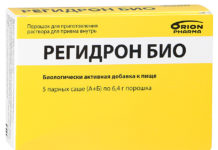The benefits and harms of asparagus have long been studied. There are many facts about this product. But no matter how culinary experts from all over the world sing it, it is definitely not useful for everyone. Let's see what is valuable in asparagus. And why should some refuse it?
Material Content:
Chemical composition, calorie content, nutritional value of asparagus
Mankind knows more than 200 types of asparagus, but only one of them is used as food. It is called medicinal or ordinary asparagus.
Both white and green asparagus belong to the same species. Only the first is part of the shoot that has grown underground, while the second is the shoots that are on the surface.
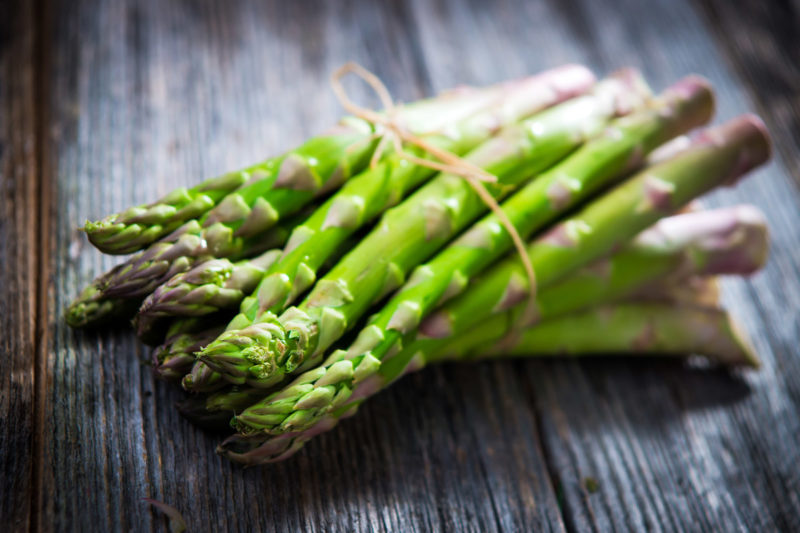
It is believed that white asparagus is healthier, it has more vitamins. And in the green part of valuable trace elements are destroyed under the influence of photosynthesis. However, connoisseurs note that the delicate shoots of emerald color taste better.
Asparagus is more than 90% water. Young stems accumulate less than 2% protein. The vegetable contains virtually no fat (0.1%). It produces very few carbohydrates (3%), but there is a sufficient amount of dietary fiber (1.5 g per 100 g of product), so the use of asparagus has a beneficial effect on the intestines.
A delicacy popular in European countries is not very nutritious. Asparagus dishes can be prepared during the diet, because 100 g of raw product contain only 20 kcal.
Despite the low energy value, the nutritional role of the vegetable crop is great. Asparagus contains group B vitamins, folic acid, vitamin C, K and β - carotene in an accessible form. Also in a small amount there is a fat-soluble antioxidant - tocopherol (vitamin E).
In the pulp, minerals accumulate: potassium, calcium, manganese, copper, phosphorus, iron, and selenium, which is important for women's health. The plant contains beneficial amino acids such as asparagine and arginine. These compounds stimulate cardiac activity and help cleanse the blood.
The sprouts contain a large number of biologically active substances - flavonoids, which are known for their antibacterial and antioxidant properties.
Asparagus - beneficial properties
First of all, the beneficial properties of asparagus are determined by the content of a large amount of dietary fiber in it. Their sufficient consumption is simply necessary for the normal functioning of the intestine. Vegetable dishes are an excellent prevention of constipation.
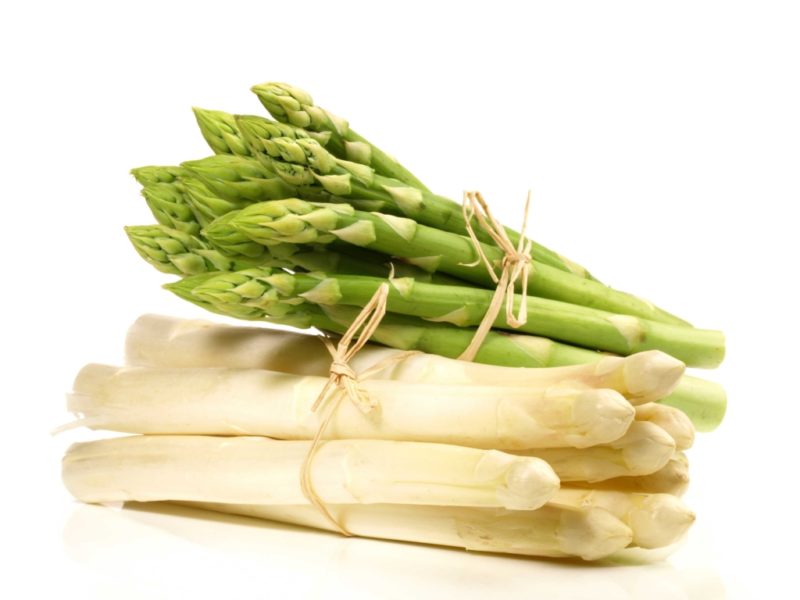
Asparagus contains substances that slightly irritate the lining of the stomach and intestines. Saponins stimulate the receptors responsible for the production of digestive juice. Delicacy contributes to the most complete and proper assimilation of food.
The ability of asparagus to stimulate the secretory activity of mucous membranes was noticed in ancient China. There, the dosage form of this plant was used as an antitussive. The use of asparagus juice promotes the formation and liquefaction of sputum, which facilitates its discharge.
Asparagus as a culture has been known to mankind for more than three thousand years. In Egypt, it was used to cleanse the liver, in Asia - for the preparation of remedies for abscesses, in Europe - for kidney diseases.
In modern dietetics, asparagus is considered an effective diuretic. Doctors recommend using it to get rid of excess fluid, reduce weight and reduce swelling.
Together with the liquid, asparagus removes excess salts from the body. Slightly reduces pressure. Thins the blood. Slows the heart rate.
It is interesting: human pressure: normal age
Benefits for men, women, children, the elderly
The beneficial properties of asparagus apply to literally everyone. Men can use it to prevent sexual impotence. Even in the Middle Ages, asparagus earned the title of a powerful aphrodisiac. In addition, it helps to fight inflammation in the urinary tract.
Women eat asparagus to preserve youth. Flavonoids, vitamins C, E and carotene have a beneficial effect on the skin. The mineral complex of asparagus supports the endocrine system, stimulates the reproductive function. Asparagus is useful in the early stages of pregnancy, as it contains folic acid, which is necessary for building the nervous system of the fetus.
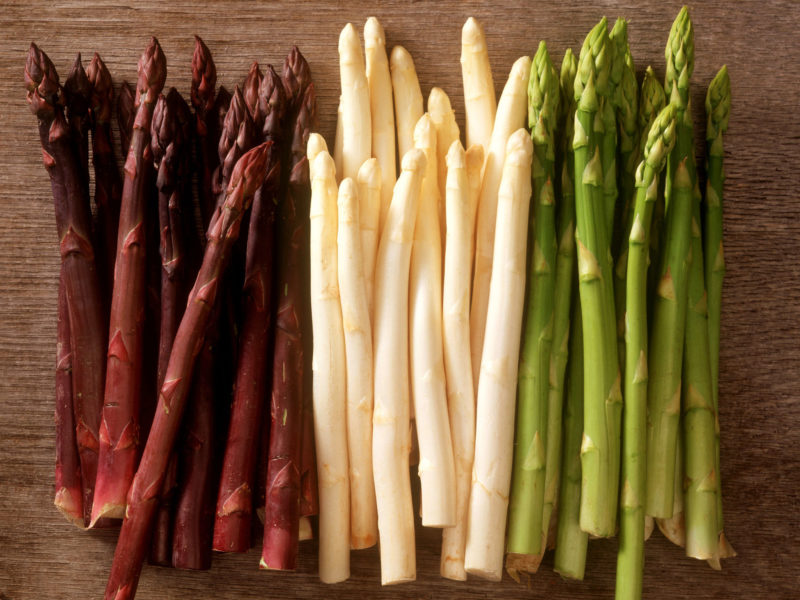
Asparagus can be added to a child’s diet starting at two years old. This product contains a large amount of potassium, which helps to form skeletal muscles. In addition, asparagus contains lysine, which has antiviral and immunomodulating activity. It is good for teenagers to eat a vegetable to prevent the appearance of acne.
Elderly people often need to pamper themselves with a delicacy. Asparagus contains a lot of substances useful for the heart. It has a mild sedative effect, slightly reduces pressure, prevents blood clotting and blood clots. Young shoots are a good way to prevent the development of atherosclerosis and diabetes.
Plant application
The edible part of the plant and sprawling rhizomes, hidden deep underground, have useful properties.
Initially, only medicines were prepared from asparagus, and only then it began to be cultivated as a vegetable crop.
Asparagus in folk medicine
In folk medicine, powder from dried rhizomes is more often used. It is measured in the right quantities, poured with boiling water and medicinal infusions are prepared from it.
Less often for brewing take the aerial part of the plant. The shoots are ground into gruel and make infusions based on this mass. From the edible part of the plant, juice is also obtained, which is also consumed for medicinal purposes.
With the help of asparagus, traditional medicine offers:
- treat urinary tract diseases;
- cleanse the liver;
- strengthen the heart muscle;
- fight high blood pressure;
- lower the level of bad cholesterol;
- to prevent diabetes;
- get rid of cough;
- strengthen immunity;
- fight joint pain with rheumatism;
- treat skin inflammatory diseases.
The duration of asparagus treatment usually does not exceed 10 days. Longer use of teas and decoctions based on the rhizome of a plant can provoke the appearance of allergic reactions.
More materials:asparagus
In cosmetology
Asparagus is used in cosmetology due to its antiseptic effect and ability to slow down aging. Asparagus broth wipe the skin to suppress inflammation and get rid of blackheads. Fresh plant juice is used for anti-aging purposes. It is applied to the face as a nourishing and moisturizing agent.
Rejuvenating masks are prepared from asparagus shoots by mixing ground pulp with other natural ingredients: dairy products, vegetable juices, and essential oils.
The benefits of losing weight
The dietary properties of asparagus have been mentioned more than once. It stimulates urination, causing the body to get rid of excess water. During an asparagus diet, the severity of edema decreases, excess salts leave the body, digestion, absorption of trace elements, and metabolism normalize.
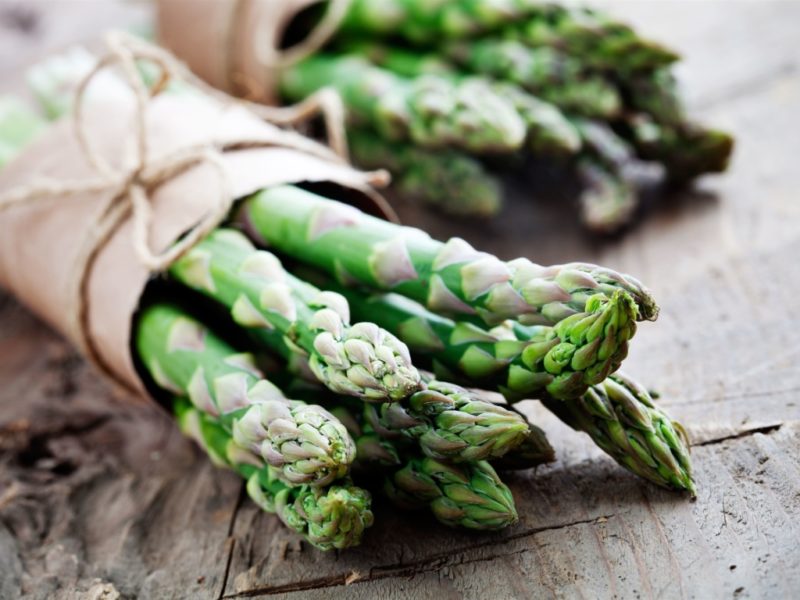
These changes lead to a natural cleansing of the body of toxins and a gradual weight loss. The plant has a low energy value, so it is difficult to oversaturated with it.
Cooking Asparagus - 5 Popular Asparagus Recipes
The young shoots themselves are very tasty. They do not require complicated cooking. The main task is not to spoil the natural product.
It is better to bake asparagus slightly, stew, boil, or steam. To preserve all the useful substances, it does not need to be prepared for a long time.
More often it is served as a side dish for steaks, fish or poultry. With cooking, it’s better not to pull. Tasty dishes come from fresh, juicy shoots.
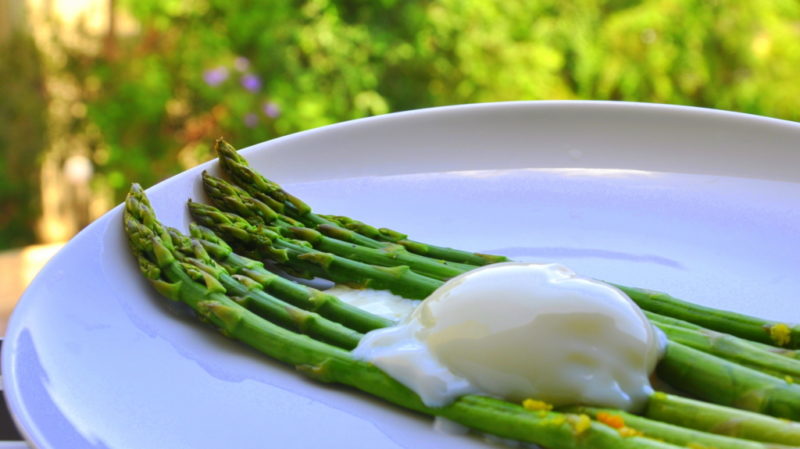
If asparagus has knotted, you need to soak it for several hours in cool water with a little sugar. Then it should be trimmed. It is very easy to do. Take the shoot at both ends, bend it, and where it has cracked you need to make a cut. Trim the remaining stems by the same amount.
Cutting off the bottom is mandatory, as it is of no value. Hemp asparagus is dense woody and unpleasant in taste. They are not eaten.
Peel the asparagus stalks, as it may make the finished dish bitter. It is most convenient to clean the asparagus with a special vegetable knife.
Braised Asparagus in Oil
The secret to this recipe is to use butter. If you did not understand the taste of asparagus before, now you will definitely taste it.
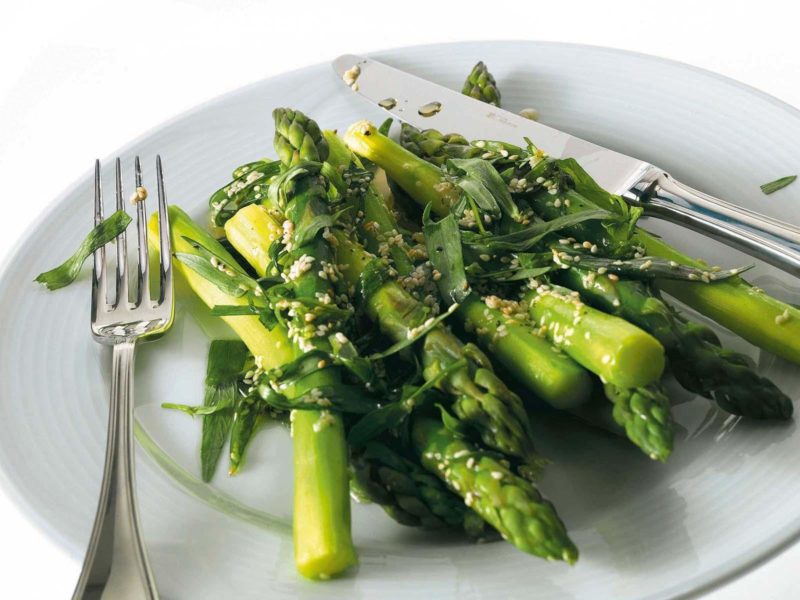
Put a tablespoon of butter in a preheated pan and add about the same amount of olive oil. After the fat has melted, throw half a spoonful of sugar and a pinch of salt into it.
Put two bundles of chopped asparagus in a pan. Shuffle. Lightly sauté it over medium heat. Then add half a glass of water. Cover and simmer for four minutes in slow heat.
Some asparagus will stand out from the asparagus. Open the cover. Turn on the fire. Stir constantly, fry vegetables until all moisture has evaporated from the bottom of the pan.
Now asparagus can be laid out on a beautiful dish and served as a side dish.
Asparagus in cheese sauce
Boil asparagus in boiling water with a little salt and sugar. After 7 minutes, you need to remove it from the pan and fill it with ice water.This is done so that the stems can maintain their beautiful green color.

The sauce is cooked in a deep saucepan, ladle or a small saucepan. First, 50 g of butter is melted. Then a spoonful of flour is added to it. All this is thoroughly mixed until the lumps disappear.
Then a glass of milk is poured into the mass. Bring almost to a boil. And in a hot mixture pour 50 g of grated hard cheese. For piquancy, you can add a few more pieces of blue cheese to the sauce.
When everything melts and becomes homogeneous, remove the stewpan from the heat. We spread several asparagus stalks on the dish, pour over the sauce and decorate with fresh chopped herbs.
Baked asparagus
In this recipe, there is no need to indicate the proportions of the ingredients. Everything is taken by eye.
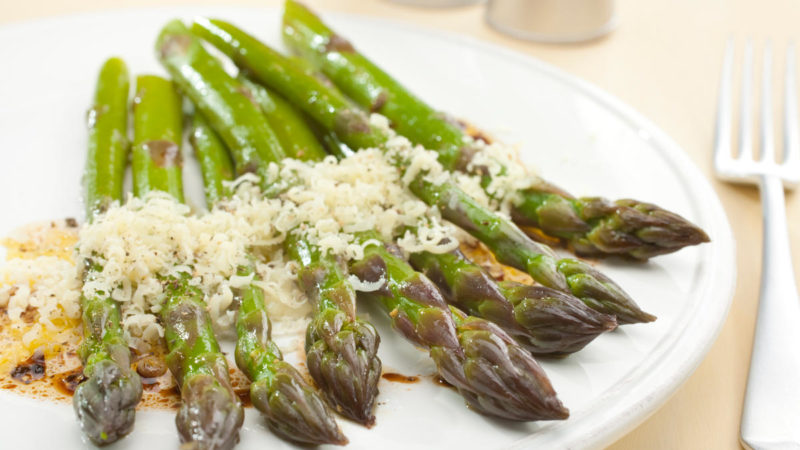
The baking sheet is plentifully greased with olive oil. Asparagus evenly spread to the bottom in one layer. Sprinkle with grated garlic. A small amount of salt. Generously watered with olive oil. Put in a hot oven (215 ° C) for 7-15 minutes.
The cooking time of the vegetable depends on the thickness of the shoots and on the degree of readiness of the dish you want to get. Thin stems can be removed after 5-7 minutes. During this period, asparagus will be baked, but will crunch a little more. If you like very soft vegetables, you can hold them in the oven for 5-10 minutes longer.
Ready asparagus should be sprinkled with grated cheese and sprinkled with lemon juice just before serving.
Omelet with Asparagus
Asparagus stalks need to be thrown in cold water, put on fire, bring to a boil and boil for 3-5 minutes. Beat 4 eggs during this time. Add to them 25 g of grated Parmesan cheese, a few torn mint leaves and a little salt.

Pour the egg mixture into a pan greased with olive oil. Fry it until half ready. Lay the stalks of asparagus in the middle, and place the omelet in a hot oven.
Hold him there for literally 2-3 minutes. Then get, put on a plate and immediately sprinkle with grated parmesan and fresh mint.
Vegetable Cream Soup
Make this soup and delight your family with a sophisticated but very simple meal. Prepare a bunch of green asparagus. Break off a stiff base from each stalk. Coarsely cut tender shoots.
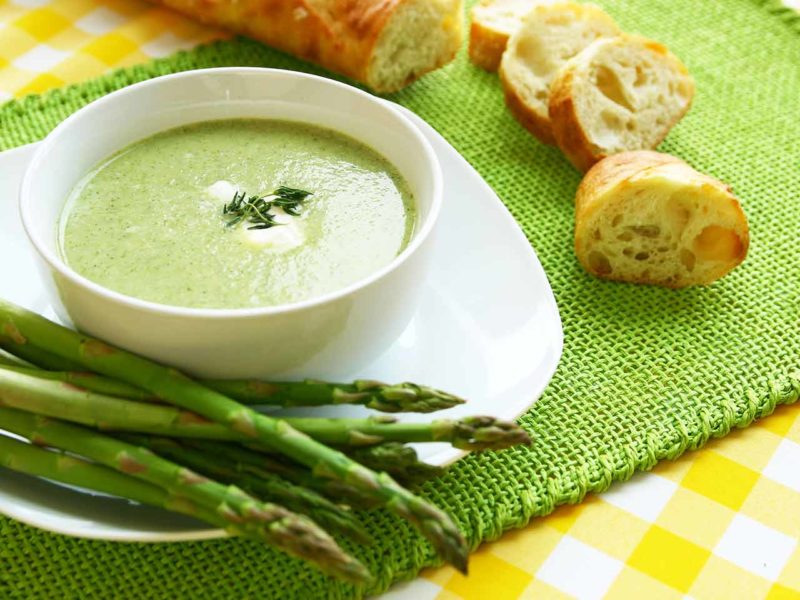
Peel one onion turnip. Chop it into large pieces at random.
Heat olive oil in a pan. Fold onions and asparagus to the bottom. Sprinkle with chopped garlic (about 5 cloves). Fry the vegetable mixture until a barely visible golden crust appears.
Put the vegetables in a saucepan. Pour half a liter of chicken stock. Bring to a boil and cook soup for 10-15 minutes until the vegetables are completely soft.
Add to them a glass of milk, salt and pepper to taste. After the contents of the pan boil, simmer everything for another 3 minutes.
Remove the soup from the stove, and use a blender to make it mashed. Pour the finished dish into plates and garnish with fried halves of asparagus stalks.
We shared the simplest recipes, thanks to which you can quickly cook delicious and at the same time healthy dishes and side dishes.
Maybe someone will remember another name - "asparagus in Korean." Immediately explain. It has nothing to do with a real vegetable. Soy asparagus or fuju is a dried froth taken from boiling soy milk. This is a product of a completely different origin. Neither in taste nor in structure does it even resemble real asparagus.
The harm of asparagus to the body
Since we have examined all the positive aspects of asparagus, it is worth talking about how it can be harmful. Some people have persistent intolerance to this vegetable. In folk medicine, there is such a term as “asparagus scabies”, this is when a susceptible person has allergic spots even after short-term contact with the product. Of course, such people should not eat asparagus.
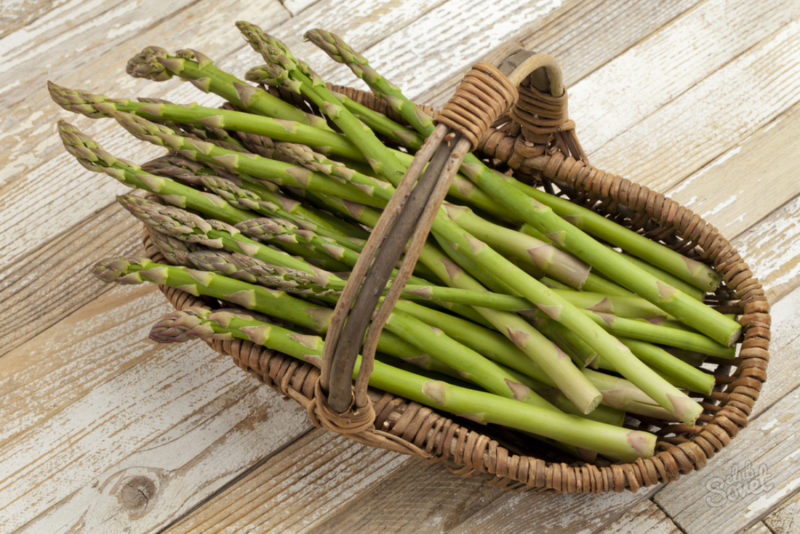
The plant is rich in saponins, which in large quantities can badly affect the irritated walls of the stomach and intestines. Therefore, in the period of exacerbation of inflammatory diseases of the digestive system, it is better to completely abandon the delicacy.
Despite the fact that asparagus helps to cope with inflammatory diseases of the urinary tract, its intake should be limited during attacks of renal colic. Since the vegetable contains a large amount of oxalic acid, it falls under the restrictions prescribed by the diet for this disease.
Otherwise, you should not be afraid of this plant. Asparagus brings a lot of benefits and pleasure. No wonder she is called the queen of vegetables. Cook delicacies, treat yourself and delight loved ones with them.







